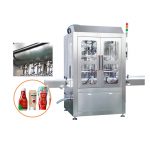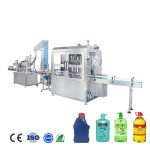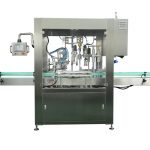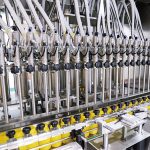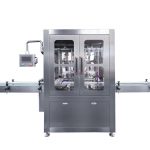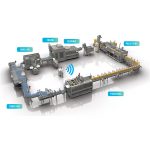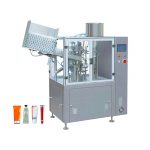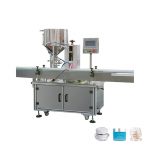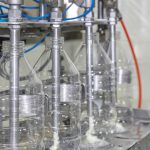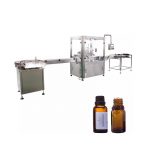What is juice filling machine?
A juice filling machine is a type of liquid packaging machine that is used to fill containers with juice. It typically consists of a series of filling nozzles that are designed to dispense precise amounts of juice into containers as they pass by on a conveyor belt. The machine is often used in commercial settings, such as juice factories or bottling plants, to efficiently and accurately fill large numbers of containers with juice.
The juice filling machine typically has a number of different components, including a conveyor belt, a filling nozzle, and a capping mechanism. The conveyor belt is used to transport the empty containers past the filling nozzle, which dispenses the juice into the containers. The capping mechanism then seals the containers to prevent the juice from spilling out.
The juice filling machine is operated by a machine operator, who is responsible for ensuring that the machine is running smoothly and efficiently. The operator typically monitors the machine and makes any necessary adjustments to ensure that the juice is being filled accurately and consistently. The machine may also be equipped with sensors and other monitoring devices to help the operator maintain control over the filling process.
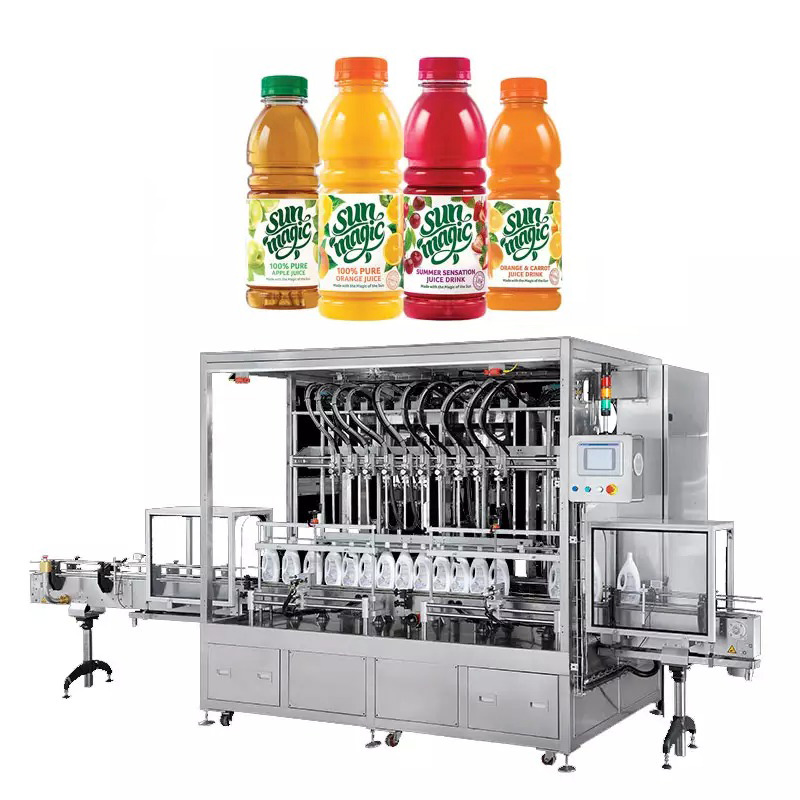
In addition to its use in juice factories and bottling plants, the juice filling machine is also commonly used in other industries that require precise filling of liquid products. For example, it may be used in the production of beverages, sauces, condiments, and other products that are packaged in containers.
Overall, the juice filling machine is a valuable tool for businesses that need to fill large numbers of containers with juice or other liquids. It allows for efficient and accurate filling of containers, which can help to reduce waste and improve the overall quality of the final product.
What are the common packaging juice containers?
The most common packaging containers for juice are glass bottles, plastic bottles, and juice boxes. Glass bottles are often used for high-quality, premium juices, as they provide a clean and attractive packaging option. Plastic bottles are more common for everyday juice products, as they are lightweight and less fragile than glass bottles. Juice boxes, which are made of flexible, thin plastic, are often used for single-serve portions of juice, and are popular with children.
Other common packaging options for juice include cans and pouches. Cans are often used for shelf-stable juice products, as they provide a durable and tamper-proof packaging option. Pouches are a relatively new packaging option for juice, and are gaining popularity due to their lightweight and convenient design.
Overall, the choice of packaging for juice products depends on a number of factors, including the type of juice, the intended market, and the desired shelf-life of the product.
How to choose juice filling machine?
When choosing a juice filling machine, there are several factors to consider. First and foremost, you need to consider the type of juice you will be filling. Different juices have different viscosities and may require different types of filling equipment. For example, some juices may be very thick and require a piston filling machine, while others may be more watery and can be filled using a gravity filling machine.
The next thing to consider is the type of container you will be filling. Different filling machines are designed to work with different types of containers, such as bottles, cans, or pouches. Make sure to choose a filling machine that is compatible with your containers.
Another important factor to consider is the capacity of the filling machine. If you have a large production operation, you will need a machine with a high filling capacity to keep up with demand. On the other hand, if you have a small operation, you may be able to get by with a smaller, more affordable filling machine.
Another key consideration is the speed of the filling machine. If you have a high-volume operation, you will need a machine that can fill your containers quickly and efficiently. On the other hand, if you have a small operation, you may not need a high-speed machine.
In addition to these factors, you should also consider the overall design and construction of the filling machine. Look for a machine that is built to last and is made with high-quality materials. You should also consider the ease of use and maintenance of the machine, as well as the availability of spare parts and technical support.
Once you have considered these factors, you should research different filling machine manufacturers and compare their products to find the one that best meets your needs. You can do this by reading online reviews, talking to other industry professionals, and attending trade shows and exhibitions.
Overall, choosing the right juice filling machine is an important decision that can have a significant impact on the success of your juice production operation. By considering the factors discussed above and doing your research, you can find a filling machine that will meet your needs and help you produce high-quality juice efficiently and cost-effectively.
What are the types of juice filling machine?
There are several different types of juice filling machines, each designed for a specific type of juice and container. Some common types of juice filling machines include:
Gravity filling machines:
Gravity filling machines use the force of gravity to fill containers with juice. They are ideal for filling containers with low-viscosity juices that flow easily, such as fruit juice, sports drinks, and water.
Pressure filling machines:
Pressure filling machines use a pressure tank to force juice into containers. They are ideal for filling containers with thicker juices that do not flow easily, such as tomato juice and other purees.
Piston filling machines:
Piston filling machines use a piston to push juice into containers. They are ideal for filling containers with very thick or viscous juices, such as smoothies and purees.
Rotary filling machines:
Rotary filling machines use a series of filling heads that rotate to fill multiple containers simultaneously. They are ideal for high-speed, high-volume filling operations.
Volumetric filling machines:
Volumetric filling machines use a measuring chamber to dispense a precise amount of juice into each container. They are ideal for filling containers with consistent, accurate doses of juice.
In addition to these types of filling machines, there are also specialized machines for filling specific types of containers, such as bottles, cans, or pouches.
When choosing a juice filling machine, it is important to consider the type of juice you will be filling, the type of container you will be using, and the capacity and speed requirements of your operation. By selecting the right type of filling machine for your needs, you can improve the efficiency and cost-effectiveness of your juice production operation.
How does the juice filling machine work?
A juice filling machine works by automatically filling containers with juice. The specific details of how a juice filling machine works will depend on the type of machine and the type of juice being filled, but the general process is similar for all juice filling machines.
First, the juice is prepared and transferred to a storage tank or hopper on the filling machine. The containers to be filled are placed on a conveyor belt and transported to the filling station. At the filling station, the containers are automatically positioned under the filling nozzle.
Next, the juice is dispensed into the container. This can be done using a variety of methods, depending on the type of filling machine. For example, a gravity filling machine uses the force of gravity to fill the container, while a piston filling machine uses a piston to push the juice into the container.
Once the container is filled to the desired level, the filling machine will automatically move it to the next station, where it can be sealed, labeled, and packaged.
Some juice filling machines are designed to fill multiple containers simultaneously, using a series of filling nozzles or rotating filling heads. These machines are capable of filling hundreds or even thousands of containers per hour, making them ideal for high-speed, high-volume juice production operations.
Overall, the process of filling juice using a filling machine is relatively simple and efficient. By automating the filling process, juice filling machines can help producers save time and labor costs, and improve the consistency and accuracy of their product.
What are the components of juice filling machine?
A juice filling machine is a complex piece of machinery that consists of several different components. These components work together to automatically fill containers with juice, and vary depending on the type and design of the filling machine.
Some common components of a juice filling machine include:
Juice storage tank or hopper:
This is where the juice is stored before it is dispensed into containers. The size of the storage tank will depend on the capacity of the filling machine and the volume of juice being produced.
Filling nozzle:
This is the part of the machine that dispenses the juice into the container. The type of filling nozzle will vary depending on the type of filling machine and the viscosity of the juice.
Conveyor belt:
This is a moving belt that transports the containers through the filling machine. The speed and direction of the conveyor belt can be adjusted to match the filling speed and container size.
Container positioning mechanism:
This is the part of the machine that positions the containers under the filling nozzle. This can be done using a variety of methods, such as mechanical arms, guides, or sensors.
Control panel:
This is the part of the machine where the operator can set the filling parameters, such as the filling speed and volume, and start and stop the filling process. The control panel may also display information about the filling process, such as the number of containers filled and any errors or malfunctions.
Safety features:
Juice filling machines are equipped with a range of safety features to prevent accidents and protect the operator. These may include emergency stop buttons, safety guards, and sensors to detect any potential hazards.
In addition to these components, a juice filling machine may also have additional features, such as labeling and packaging stations, and may be integrated with other equipment, such as sterilization or capping machines.
Overall, the components of a juice filling machine work together to automate the filling process and produce high-quality juice efficiently and cost-effectively.
What are the advantages of juice filling machine?
A juice filling machine is a useful piece of equipment for any juice production operation. It offers several advantages over manual filling methods, including increased speed and efficiency, improved consistency and accuracy, and reduced labor costs.
One of the main advantages of a juice filling machine is its speed and efficiency. Modern filling machines are capable of filling hundreds or even thousands of containers per hour, allowing producers to keep up with demand and maximize their output. This can be especially important for large-scale operations that need to fill a high volume of juice quickly and efficiently.
Another advantage of a juice filling machine is its ability to fill containers with consistent, accurate doses of juice. Unlike manual filling methods, which can be prone to errors and inconsistencies, a filling machine can dispense precise amounts of juice into each container. This can help producers maintain the quality and consistency of their product, and reduce waste due to over- or under-filling.
A juice filling machine can also help reduce labor costs by automating the filling process. Rather than having employees manually fill each container, a filling machine can do the work automatically, freeing up workers to focus on other tasks. This can help producers save money on labor costs and increase their overall efficiency.
In addition to these advantages, a juice filling machine can also improve the safety of the filling process. Modern filling machines are equipped with a range of safety features, such as emergency stop buttons and safety guards, to prevent accidents and protect the operator. This can help reduce the risk of injury and improve the overall safety of the filling operation.
Overall, the advantages of a juice filling machine make it a valuable investment for any juice production operation. By automating the filling process, a filling machine can help producers increase their speed and efficiency, improve the quality and consistency of their product, and reduce labor costs.

